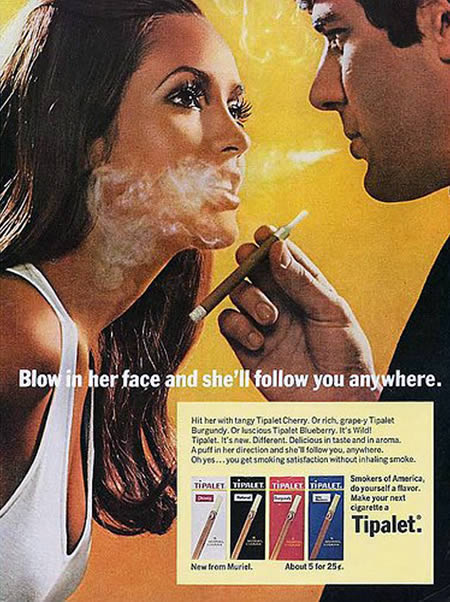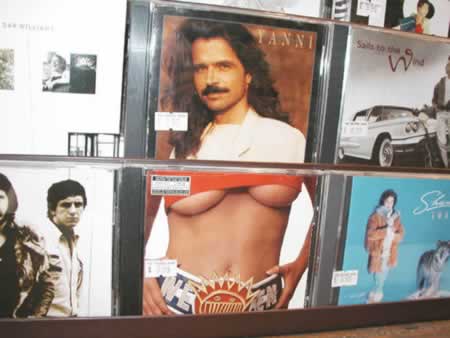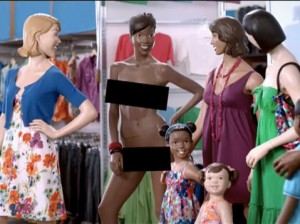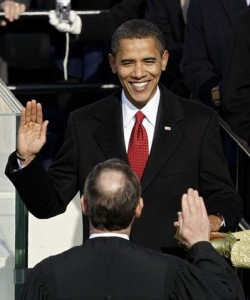
How is it that even small children have a built-in notion of justice and balance? Why is my old employer—I briefly worked as a cashier for GMAC, now Ally Bank, in my 20s—playing on that sense of fairness in a series of new spots?
Educate and excite, inform and infuriate.
June 1st, 2009 — Advertising, Children, Humor

How is it that even small children have a built-in notion of justice and balance? Why is my old employer—I briefly worked as a cashier for GMAC, now Ally Bank, in my 20s—playing on that sense of fairness in a series of new spots?
May 29th, 2009 — Advertising, Black Music, Food, TV
I don’t know how actor/comedian Chris Hardwick keeps getting work, but I’m suddenly glad he does.
May 25th, 2009 — Advertising, Gender, Sex

With its hint of nipple and textual/visual allusion to a cum “facial,” this classic 1970s print piece for Tipalet cigars, above, may be the most explicit of the 15 Sexist Vintage Ads in this collection. (As well, this one, for Tangee lipstick, proves that oral fixations aren’t new in the advertising business.) But for sheer outrage, you may like the husband showing his wife how to make his coffee, or better, this one for Mr. Leggs pants.
Hold it: In the ad, above, is that Vivica A. Fox?
May 19th, 2009 — Advertising, TV
Dos Equis (Spanish for “two X’s”) wins again with their wildly tongue-in-cheek advertising. In the brewer’s latest campaign, their spokesman is “the most interesting man in the world”: A nameless, bearded, ultra-virile, ultra-Latin quasi-composite, above, who counsels us to “Stay thirsty, my friends,” as he proffers the brew. Though the copy for this spot, like all of them, is spot-on absurd (“He’s a lover, not a fighter…but he’s also a fighter, so don’t get any ideas”), my favorite piece may be Mr. Dos Equis’—can we call him that?—take on rollerblading.
May 12th, 2009 — Advertising, Crime, Sports
What really comes through in O.J. Simpson’s 1970s commercials for Hertz is how much charm and charisma he possessed, and how much the camera loved him. It’s really easy to see, even apart from his much-heralded performances on the football field, why he was a natural, and extremely popular, spokesperson for the brand.
That O.J. Simpson was ever beloved, of course, may certainly be a revelation for lots of young people, many of whom are not even old enough to remember to remember his 1994-95 murder case and trial, not to mention his TV spots or NFL triumphs. Now, of course, Simpson couldn’t even get an endorsement from a knife company, and that’s coming from someone who doesn’t necessarily believe he killed his wife, Nicole Brown Simpson, and her friend, Ronald Goldman in June ’94. But what do I know?
May 6th, 2009 — Advertising, Hip-Hop, Music, TV
Yet, “Rapper’s Delight” isn’t the best aspect of “Cog,” a 2-minute Honda commercial, produced by Nike stalwarts Wieden + Kennedy, which aired in the UK during 2003. That would be its sheer visual inventiveness and luscious backstory, one of filmmakers going to insane limits to create a vision that, until the moment the lights go dark, only exists inside their heads.
I recently discovered this spot while doing research on Rube Goldberg machines…and I was looking those up as an aspect of some religious writing I’m doing…which is, I should say here, what I’ve always loved about the net and, certainly by extension, Wikipedia: Its serendipitous nature, and that, following it, you never end up where you started or expected…that being, I think you’ll agree, what this advertisement is about, too.
May 5th, 2009 — Advertising, Design, Photography

While this juxtaposition of Yanni’s 1992 Dare To Dream and Ween’s 1994 Chocolate and Cheese CD covers, above, encourages a freaky moment of sexual ambiguity—due, depending on your orientation, to Mr. Chryssomallis’s striking ‘stache or model Ashley Savage’s bodacious ta-tas—it’s got nothing on this catalog of 15 unfortunately placed ads.
The lineup includes billboards for a juicer and a fitness center that should have got someone fired, and a subtle computer error jab. But, mostly, they appear to be combinations of content and advertising created by web-based optimizing software; the kind that, based on keywords, sticks a relevant advertisement on the page one is reading. Of course, as this coffee ad shows, sometimes the placement is just a little bit too relevant.
March 23rd, 2009 — Advertising, Fashion, History, Media, Race
So wrote Leroy Colson of Detroit MI this past Friday, in an e-mail to MEDIA ASSASSIN. The Lord and Taylor ad to which he refers, above, shows two models wearing pink, $150 Ellen Tracy trench coats.
Well, rather, one of them—the white one facing the camera—wears the coat. The other one—the Black one with her back to you—can’t help flashing a white man walking by with two dogs, both of which, if you look closely, have their eyes punningly trained on her putty-tat. The auburn-colored chow is even tugging like he’s gonna run after it.
 Colson tipped me to this image after he read this past Thursday’s post, “Are There Racists at Old Navy, or Do They Think That We’re Dummies?” That piece described what I perceived as the underlying racial code of the current Old Navy “Mid-Town Flash” commercial.
Colson tipped me to this image after he read this past Thursday’s post, “Are There Racists at Old Navy, or Do They Think That We’re Dummies?” That piece described what I perceived as the underlying racial code of the current Old Navy “Mid-Town Flash” commercial.
It’s the one in which a Black store mannequin, above right, has her dress ripped off, leaving her, except for matching black bars, naked before her co-mannequins, as the incident is played for laughs, including her own.
Exactly what are the chances that a random individual, reading an article critiquing the public racial display of the nude Black female body, would, that same day, be sent another, unrelated ad, also racially displaying the nude Black female body in public? (By racial, I mean anything said or done that involves white people with non-white people.)
Maybe the chances are high. Perhaps having noticed such an ad, a viewer’s heightened attention might readily be drawn to another different one. But, hey: Are there that many of these around? Is this a sub-category? I mean, we’re not talking about something akin to the millions of spreads featuring pictures of, say, mothers gently feeding their babies, here, right?
 Oops: I spoke too soon, suddenly recalling clothing maker Benetton’s notorious 1989 ad, right, something the company called part of its “campaign for equality between black and white,” proudly noting that, while controversial, it “represents the most-awarded image in Benetton’s advertising history.”
Oops: I spoke too soon, suddenly recalling clothing maker Benetton’s notorious 1989 ad, right, something the company called part of its “campaign for equality between black and white,” proudly noting that, while controversial, it “represents the most-awarded image in Benetton’s advertising history.”
Clothing, white customers, Black women’s bodies: There’s almost something antebellum about the mix. How much of this sort of advertising exists? Why does it? Why does it always involve a Black woman being eyed by a white man—or in this case, suckling one—but never the reverse? I’m just asking those questions rhetorically. I’m Black, and, like Thulani noted in her comments, I know that
If a black kid had ripped the dress of a “white” mannequin, it would have [been] read as hostile in a racial way but it would not evoke many similar images from the past– there is no tradition of exposing white women’s bodies on the slave block. [Eds. note: Though, clearly, the slave block and suckling white infants are deeply intertwined.] … If the company meant to imply that the dresses were so cute the customers were ripping them off the mannequins, having them all ripped would have made the point in a non-racialized way.
In other words, there’s a relationship between what’s not permitted in reality and what’s not permitted symbolically, and the reverse is also true. Which was my original point: I believe the line from the auction block to the display stand is unbroken.
So, while I can’t prove they’re directly related, for example, it’s not odd to me that, that, in a country which tends towards these kinds of displays, a 2000 Congressional report found that “Black women were nearly twice as likely to be strip-searched on suspicion of smuggling drugs as white men and women.”
In any event, it’s fascinating the response last week’s post provoked. Besides the comments, perhaps the best indicator of the nerve it hit is that, on the day it went out, twenty of the people following me on Twitter quit doing so. (My followers automatically get tweets linking them to each day’s new MEDIA ASSASSIN post.)
Twenty is far more than have ever canceled me in one day. (The highest before that was seven.) In fact, twenty is more than half of all my Twitter unfollows to-date. Hopefully, most of them will come back when they see this post.
March 19th, 2009 — Advertising, Fashion, History, Media, Race
“Images of Black women that are in fact ‘national, racial, and historical hallucinations’ have been ingrained into the collective conscience of the United states since slavery. Black women have been depicted either naked, generally in an ethnographic context, or as laborers, usually domestic, their social status playing a crucial role in the development of visual identity. With rare exceptions, representations of the Black woman in art and photography have followed these prescribed lines.”—Kimberly Wallace-Sanders, Skin Deep, Spirit Strong: The Black Female Body in American Culture (Ann Arbor: University of Michigan Press, 2003), p. 182.
“I ‘members when they put me on the auction block. They pulled my dress down over my back to my waist, to show I ain’t gashed and slashed up. That’s to show you ain’t a mean nigger.”—Lu Perkins, quoted by James Mellon, ed., Bullwhip Days: The Slaves Remember: An Oral History (New York: Avon Books, 1988), p. 292.
In his 1985 book on the Atlanta child murders, The Evidence of Things Not Seen, writer James Baldwin (1924-1987) spoke of the “ancestral, daily, historical truth of Black life in this country,” then paused to note that, in the context of the African-American experience, the words “ancestral and daily are synonyms.” That is, they have the same meaning.
 What Baldwin, right, meant by that is what Black people state when they, speaking of the same conditions, inelegantly say, “Samo, samo.” In other words, same old thing, nothing’s different in any meaningful way. “You try and get ahead and they change the rules.” Whatever Black people do, white supremacy merely adapts. Or, as I often urge, “Why would they change what works?”
What Baldwin, right, meant by that is what Black people state when they, speaking of the same conditions, inelegantly say, “Samo, samo.” In other words, same old thing, nothing’s different in any meaningful way. “You try and get ahead and they change the rules.” Whatever Black people do, white supremacy merely adapts. Or, as I often urge, “Why would they change what works?”
It is utterly fascinating to see how frustrating these contentions remain to many white people. Their notion of history is heroic; a series of climaxes that they, like chiseled, blood-spattered action heroes, have wrangled. (Baldwin, right, of course, knew this, and in the aforementioned quote added that “historical does not refer to that spotless mirror in which the bulk of White North Americans imagine they see their faces,” but the actual, true history that Black people have borne.)
 Of course, when it comes to action-packed heroics, nothing tops this past November’s election and inauguration, right, of the current president. It was an achievement which moved many white people to quickly declare the age of Obama “post-racial.” A greater number said, more generously, but no less absurdly, that, in the wake of seating a Black president, “America had changed forever.” Pundit after pundit, in kind, asserted America’s “maturity” with this act.
Of course, when it comes to action-packed heroics, nothing tops this past November’s election and inauguration, right, of the current president. It was an achievement which moved many white people to quickly declare the age of Obama “post-racial.” A greater number said, more generously, but no less absurdly, that, in the wake of seating a Black president, “America had changed forever.” Pundit after pundit, in kind, asserted America’s “maturity” with this act.
Doesn’t having white people write their own absolution preserve white supremacy as a system? All of this, to me, had the quality of, after a home invasion and robbery, agreeing to let the thief fill out one’s insurance claim and police report. At the very least, one can agree that having the people who have victimized you quantify your mistreatment invokes a sizable conflict of interest.
Though all of the above is deeply relevant, none of this was on my mind Tuesday night, when, while watching American Idol, I saw an Old Navy commercial, titled “Mid-Town Flash,” below, in which a white actor, with one brisk move, strips off a Black female mannequin’s dress, leaving the figure, above, save for modesty bars, completely naked, smiling, and being curiously observed by her fellow mannequins, or “supermodelquins,” as the group are called in the corporation’s series of ads.
March 11th, 2009 — Advertising, Books, Photography
“As Gregor Samsa awoke one morning from uneasy dreams he found himself transformed in his bed into a gigantic insect.”
With that disorienting, opening sentence, Franz Kafka’s 1915 novella The Metamorphosis begins its dreadful spiral into insanity. But to photographer Marc Paeps, and Air, a Brussels ad agency tasked with getting readers into local Filigranes Bookstores, Kakfa’s text inspires this image, above: That of a despondent, six-legged Samsa, cut off from the world in a sleazy motel, wasting his few remaining days and dollars on booze, hookers, and coke. (Click on the picture to see the much larger version’s sordid details.) The campaign’s theme is, “Make your own movie: Read a book.” Man, if that’s what’s inside books, I’m just gonna keep on watching American Idol.
[via Ads of the World]